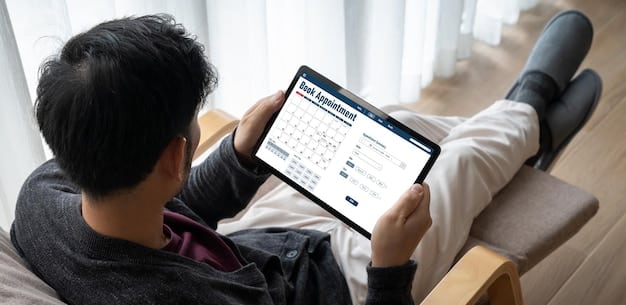Learn Korean with Doramas: A US Fan’s Guide Beyond Subtitles

Beyond Subtitles: Learning Korean Through Your Favorite Doramas – A US Fan’s Guide offers American fans a fun and effective approach to language acquisition by leveraging the immersive experience of K-dramas, focusing on practical language skills and cultural understanding.
Are you a US fan of Korean dramas (doramas) and dream of understanding the dialogue without relying on subtitles? Beyond Subtitles: Learning Korean Through Your Favorite Doramas – A US Fan’s Guide unlocks the potential of your favorite shows to become an engaging and effective language learning tool.
Unlock Korean Fluency: Doramas as Your Language Partner
For many US residents, Korean dramas have become more than just entertainment; they’re a window into Korean culture and a potential gateway to language acquisition. Learning Korean can seem daunting, but by utilizing the context and immersion provided by doramas, you can turn entertainment into education.
This approach is not just about memorizing vocabulary and grammar rules. It’s about engaging with the language in a natural and enjoyable way, allowing you to internalize expressions, understand cultural nuances, and improve your listening comprehension.
Why Doramas are a Great Resource
Doramas offer a unique advantage for language learners. The visual context provides cues that aid comprehension, even if you don’t understand every word. Furthermore, the repetitive nature of common phrases and expressions in doramas helps reinforce learning.
- Contextual Learning: Understand words in their natural environment, not just in isolation.
- Cultural Immersion: Gain insights into Korean customs, etiquette, and social norms.
- Motivating and Engaging: Learning becomes fun when it’s tied to your favorite shows.
- Improved Listening Skills: Train your ear to recognize Korean pronunciation and intonation.

By actively engaging with doramas, US fans can transform their viewing experience into a productive learning opportunity, bridging the gap between entertainment and language proficiency.
Getting Started: Choosing the Right Doramas
Not all doramas are created equal when it comes to language learning. Some are more dialogue-heavy, while others may use more complex vocabulary or slang. Choosing the right doramas can significantly impact your learning experience.
Consider doramas that align with your current Korean language level. Beginners may benefit from shows with simpler storylines and more common vocabulary, while more advanced learners can challenge themselves with historical dramas or shows that feature specialized terminology.
Factors to Consider When Choosing Doramas
Several factors can help you pick doramas that are suitable for language learning. Firstly, think about your personal interests. If you’re passionate about a particular genre, you’re more likely to stay motivated.
- Genre: Select doramas based on the topics and themes you enjoy.
- Difficulty Level: Start with shows that have relatively simple dialogue and clear pronunciation.
- Availability of Subtitles: Ensure that accurate Korean and English subtitles are available.
- Length of Episodes: Shorter episodes can be less overwhelming for beginners.
By carefully selecting doramas, you can optimize your learning experience and make the most of your time invested in watching and analyzing the content.
Active Viewing Techniques: Learning Beyond Passive Watching
Simply watching doramas won’t magically make you fluent in Korean. To truly learn, you need to engage in active viewing techniques. This involves actively listening, taking notes, and practicing pronunciation.
Active viewing is about transforming your experience from passive entertainment to active learning. It requires you to focus, analyze, and engage with the language in a way that promotes retention and application.
Strategies for Active Viewing
There are several practical strategies you can employ to enhance your learning while watching doramas. These include pausing, repeating, and looking up unfamiliar words.
- Pause and Repeat: Stop the show after short segments and repeat the dialogue aloud.
- Look Up Unfamiliar Words: Keep a notebook handy and write down any new vocabulary you encounter.
- Take Notes on Grammar: Pay attention to sentence structure and grammatical patterns.
- Use Subtitles Strategically: Start with Korean subtitles, then switch to English if needed, and eventually try watching without subtitles.
By implementing these strategies, you can convert your dorama watching sessions into effective and enjoyable language learning exercises.
Decoding Subtitles: A Tool, Not a Crutch
Subtitles are an invaluable tool for language learners, but it’s crucial to use them effectively. Relying solely on English subtitles can hinder your progress in developing listening comprehension skills.
The goal is to gradually wean yourself off English subtitles and eventually be able to understand the dialogue without any assistance. This requires a strategic approach to subtitle usage.

Maximizing the Benefits of Subtitles
To maximize the benefits of subtitles, consider adopting a tiered approach. Start with Korean subtitles to train your reading skills and familiarize yourself with the written language.
- Step 1: Korean Subtitles: Watch with Korean subtitles to improve reading skills.
- Step 2: English Subtitles: Switch to English subtitles only when needed to understand complex phrases.
- Step 3: No Subtitles: Gradually try watching without subtitles to test your comprehension.
By using subtitles strategically, you can strike a balance between comprehension and language development, ultimately enhancing your ability to understand Korean without relying on external aids.
Beyond Vocabulary: Understanding Cultural Nuances
Learning a language is not just about memorizing words; it’s also about understanding the cultural context in which the language is used. Doramas offer a rich source of cultural insights that can enrich your learning experience.
Cultural nuances often play a significant role in communication, and understanding these nuances can help you avoid misunderstandings and communicate more effectively with native speakers.
Discovering Korean Culture Through Doramas
Korean dramas often reflect Korean values, traditions, and social customs. Paying attention to these elements can provide valuable insights into the cultural context of the language.
- Respect and Hierarchy: Observe how honorifics are used to show respect to elders and superiors.
- Social Customs: Take note of common greetings, gestures, and etiquette in various social situations.
- Family Dynamics: Examine how family relationships are portrayed and the importance of filial piety.
- Traditions and Holidays: Learn about Korean holidays and traditional customs through their depiction in dramas.
By immersing yourself in the cultural context of doramas, you can gain a deeper appreciation for the Korean language and its nuances, enhancing your ability to communicate effectively and authentically.
Practice Makes Perfect: Applying What You’ve Learned
The key to mastering any language is consistent practice. Watching doramas is a great start, but you need to actively apply what you’ve learned in real-life situations. This could involve speaking with native speakers, writing in Korean, or simply thinking in Korean.
Practice is the bridge between passive learning and active mastery. It’s through consistent and deliberate practice that you solidify your knowledge and develop fluency.
Ways to Practice Your Korean Skills
There are many ways to incorporate practice into your daily routine. You can find language exchange partners online, join a Korean language club, or even start a Korean language journal.
- Language Exchange: Find native Korean speakers who want to learn English.
- Korean Language Clubs: Join a local or online community of Korean language learners.
- Language Learning Apps: Utilize apps like Duolingo, Memrise, or HelloTalk to reinforce vocabulary and grammar.
- Speak with Native Speakers: Engage in conversations with Korean-speaking friends or online tutors.
By actively practicing your Korean skills, you can reinforce what you’ve learned from doramas and accelerate your progress towards fluency.
| Key Point | Brief Description |
|---|---|
| 🎉 Engaging with Doramas | Use Korean dramas as an enjoyable method for learning the Korean language. |
| 🎬 Choosing Suitable Doramas | Select doramas that match your skill level and interests for optimal learning. |
| ✍️ Active Viewing | Engage in active viewing techniques like pausing, note-taking, and repetition. |
| 🗣️ Practicing Regularly | Apply what you learn from doramas through speaking, writing, and language exchange. |
Frequently Asked Questions
▼
While doramas alone won’t make you fluent, they’re a fantastic supplementary tool. They provide context, cultural insights, and listening practice that traditional methods often lack, making learning more engaging and effective.
▼
Rom-coms and family dramas with everyday scenarios are ideal. Look for shows with clear enunciation, simple plots, and vocabulary focused on daily life to ease your way into the language.
▼
Consistency is key. Aim for at least a few episodes a week, focusing on active viewing rather than passive watching. Regular, shorter sessions can be more effective than sporadic marathon viewings.
▼
Start with Korean subtitles to boost reading skills, then switch to English only when needed. Gradually try watching without subtitles to challenge your comprehension and improve listening skills.
▼
Don’t get discouraged. Use online dictionaries, language learning forums, or tutors to clarify doubts. Rewatch segments to reinforce understanding and make notes of recurring vocabulary or grammar points.
Conclusion
Beyond Subtitles: Learning Korean Through Your Favorite Doramas – A US Fan’s Guide offers a fresh and engaging approach to language learning, leveraging the popularity and accessibility of K-dramas. By combining strategic viewing techniques with consistent practice and cultural exploration, American fans can unlock a fun and effective path to Korean fluency, turning their passion for doramas into a valuable language-learning journey.





